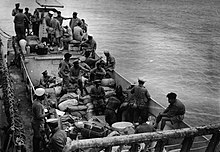Royal Indian Navy
The East India Company was established in 1599, and it began to create a fleet of fighting ships in 1612, soon after Captain Thomas Best defeated the Portuguese at the Battle of Swally.This led the company to build a port and to establish a small navy based at Suvali, in Surat, Gujarat, to protect its trade routes.[9] In 1635, the East India Company established a shipyard at Surat, where they built four pinnaces and a few larger vessels to supplement their fleet.[8] In February 1756, the Marine supported the capture of Gheriah (Vijaydurg Fort) by Robert Clive and Admiral Watson, and was active in skirmishes against the French, helping to consolidate the British position in India.[8] In 1809, a fleet of 12 ships of the Marine bombarded the city of Ras al-Khaimah, a pirate stronghold, in an unsuccessful attempt to quell Arab piracy.[16] The former adopted the general lines of the Naval Discipline and Indian Navy Acts as far as possible, whilst the latter merely supplied deficiencies in regard to grading and rating.[19] When mines were detected off the coasts of Bombay and Aden, during the First World War, the Royal Indian Marine went into action with a fleet of minesweepers, patrol vessels and troop carriers.Besides patrolling, the Marine ferried troops and carried war stores from India to Mesopotamia (now Iraq), Egypt and East Africa.These six ships and the minesweepers all eventually proceeded to India carrying out various duties in the North Atlantic, Mediterranean and Cape stations en route.These included HMIS Bengal, which was a part of the Eastern Fleet during World War II, and escorted numerous convoys between 1942 and 1945.At midnight on 9 December 1941, HMS Glasgow sank the RIN patrol vessel HMIS Prabhavati with two lighters in tow en route to Karachi, with 6-inch shells at 6,000 yards (5,500 m).On 11 November 1942, Bengal was escorting the Dutch tanker Ondina[37] to the southwest of Cocos Islands in the Indian Ocean.[36][39] On 12 August 1944, the German submarine U-198 was sunk near the Seychelles, in position 03º35'S, 52º49'E, by depth charges from HMIS Godavari and the British frigate HMS Findhorn.[41] The mutiny found widespread support and spread all over India, including elements in the Army and the Air Force.[45] In May 1948, Ajitendu Chakraverti became the first Indian commodore in the post-independence RIN, in the appointment of Chief of Staff Naval HQ.[46] On 21 June 1948, the additional designation of "Chief of the Naval Staff" was added before that of "Commander-in-Chief, Royal Indian Navy.




Indian NavyPakistan NavyCompany RajDominion of IndiaBombaySeven Years' WarAmerican War of IndependenceNapoleonic WarsAnglo-Burmese WarsFirst Opium WarSecond Opium WarFirst World WarSecond World WarBritish IndiaPresidency armiesIndian ArmyRoyal Indian Air Forcepartition of IndiaRoyal Pakistan NavyHistory of the Indian NavyIndian Rebellion of 1857HMIS BombaySydney HarbourMyebonHMIS SutlejHong KongEast India CompanyCompany rule in IndiaList of vessels of the Bombay Marine (1798)Thomas BestPortugueseBattle of SwallySuvaliGujaratmerchant shippingGulf of CambayNarmadaghurabsgallivatsgunboatsshipyardpinnacesMarathasCommodore William JamesMarathaSeverndroogVijaydurg FortRobert CliveRas al-KhaimahHCS Hugh LindsayJeddahAden ExpeditionSiege of MultanAnglo-Sikh WarSecond Anglo-Burmese WarRoyal NavyAdmiral Charles AustenGeneral GodwinMartabanRangoonCalcuttaParliament of the United KingdomLong titleCitation47 & 48 Vict.Royal assent29 & 30 Vict.Merchant Shipping Act 185417 & 18 Vict.minesweepersMesopotamiaEast AfricaWomen's Royal Indian Naval ServicesloopsHMIS SutlejHMIS JumnaGerman battleship BismarckHMIS CauveryHMIS KistnaHMIS NarbadaHMIS GodavariHMIS KathiawarHMIS KumaonHMIS BaluchistanHMIS CarnaticHMIS KhyberHMIS KonkanHMIS OrissaHMIS RajputanaHMIS RohilkhandBathurst-class sloopsHMIS BengalEastern FleetOperation HuskySicilyBurma CampaignHMIS PathanGalvaniEast African CampaignAttack on Pearl HarborHMS GlasgowLaccadive IslandslightersHMIS IndusWilliam Denny and BrotherscommissionedJava Sea campaignHMIS Bombayattack on Sydney HarbourOndinaCocos Islandscommerce raidersHōkoku MaruJapanese submarine Ro-110HMAS LauncestonHMAS IpswichGerman submarine U-198Seychellesdepth chargesHMS FindhornRoyal Indian Navy MutinyAir ForceDominion of PakistanHMIS Hindustanfrigatesnaval trawlers